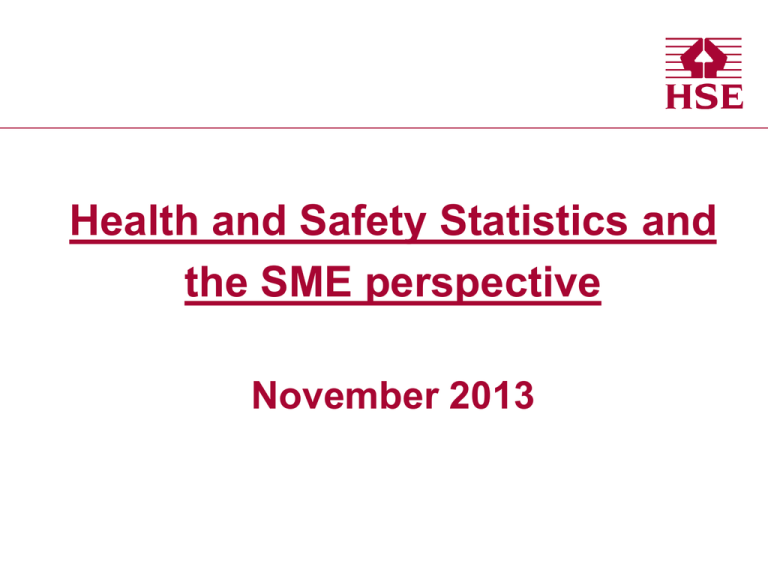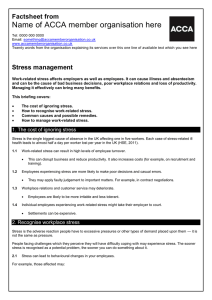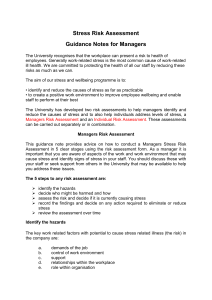SME Perspectives - 6 November 2013
advertisement

Health and Safety Executive Health and Safety Statistics and the SME perspective November 2013 Health and Safety Executive Whole economy overview Fatal injuries in the workplace Self-employed Employee Worker fatal injury rate 1.2 250 1 200 0.8 150 0.6 100 0.4 50 0.2 0 Rate of fatal injury (per 100 000 workers) 300 1.4 0 93 /9 4 94 /9 5 95 /9 6 96 /9 7 97 /9 8 98 /9 9 99 /0 0 00 /0 1 01 /0 2 02 /0 3 03 /0 4 04 /0 5 05 /0 6 06 /0 7 07 /0 8 08 /0 9 09 /1 0 10 /1 1 11 /1 12 2 /1 3p Number of fatal injuries to workers 350 •Fatalities to workers reduced slightly in 2012/13 (148 compared with 171 in 2011/12) • Evidence of a levelling off in downward trend over past 5 years Self-reported injuries (LFS) Note: average sampling variability +/- 6% on the total 1000 Cases (thousands) 900 800 700 600 500 400 300 200 100 0 2003/04 2004/05 2005/06 2006/07 2007/08 2008/09 2009/10 2010/11 2011/12 2012/13 Over 7 days Between 4 and 7 days Less than 4 days Underlying trend in RIDDOR data •Change to Over-7-Day reporting from Over-3-Day reduced reports by approximately 30% (no suggestion that the change affected major injury reporting) • Modelling suggests the underlying trend is still downwards for the whole economy series New cases of work-related ill health 2011/12 Note: average sampling variability +/- 7% on the total 700 New cases (thousands) 600 500 400 300 200 100 0 2003/04 2004/05 2005/06 2006/07 Musculoskeletal disorders Other illnesses 2007/08 2008/09 2009/10 2010/11 Stress, depression or anxiety 3 year average 2011/12 Days lost from work-related injury or illness Note: average sampling variab ility +/- 9% on the total 45 40 Days lost (millions) 35 30 25 20 No ill health data collected 15 10 5 0 2000-02 2002/03 2003/04 2004/05 2005/06 2006/07 2007/08 2008/09 2009/10 2010/11 2011/12 2012/13 Due to workplace injury • Due to work-related illness 5.2 million working days were lost in 2012/13 due to injury – on average 8.1 days per injury Cost to society of H&S failings 2006/07-2011/12 (2011 prices) Note: average sampling variab ility +/-8% on the total Injury 18 Illness 16 14 £ (billions) 12 10 No ill health data collected 8 6 4 2 0 2006/07 2007/08 2008/09 2009/10 2010/11 2011/12 •Workplace injuries and ill health (excluding cancer) cost society an estimated £13.8bn in 2010/11 (2011 prices) SME statistics – some challenges • RIDDOR suffers from substantial underreporting, and this is a particular issue for injuries in SMEs and the self-employed. Workplace size field is also poorly recorded • Reliance on survey data to give a fair comparison BUT small sample sizes often prevent detailed exploration Work-related ill health 2011/12 4500 4000 Rate per 100 000 workers 3500 3000 2500 2000 1500 1000 500 0 Small (less than 50 employees) Medium (50-249 employees) New cases of WR ill health Large (250+ employees) Total WR ill health Rates of work-related MSD 2011/12 2000 1800 Rate per 100 000 workers 1600 1400 1200 1000 800 600 400 200 0 Small (less than 50 employees) Medium (50-249 employees) New cases of MSDs • Large (250+ employees) Total cases of MSDs No difference in levels of musculoskeletal disorders by organisation size Rates of work-related stress 2011/12 2200 2000 Rate per 100 000 workers 1800 1600 1400 1200 1000 800 600 400 200 0 Small (less than 50 employees) Medium (50-249 employees) New cases of stress, depression or anxiety • Large (250+ employees) Total cases of stress, depression or anxiety Total cases of work-related stress, depression or anxiety are higher in large organisations than in SMEs Rate of injury (over 3 day absence) 3 year average – 2010/11-2012/13 1200 Rate per 100 000 workers 1000 800 600 400 200 0 Small (less than 50 employees) • Medium (50-249 employees) Large (250+ employees) Medium sized organisations have higher injury rates than either small or large – but all have shown a decrease in injury levels over time Injury and ill health rates for SMEs by industry sector 5 year average rates Injury rate per 100,000 workers 2,000 1,500 1,000 500 0 0 500 1000 1500 2000 2500 Ill-health rate per 100,000 workers Agriculture Manufacturing Construction Wholesale and retail trade Accommodation and food services Transportation and storage Information, financial activities, real estate Public administration Education Human health and social work Other service activities How is H&S managed in practice at the workplace • Effective health and safety management practices in the workplace fundamental to securing improvement in health and safety outcomes. • 2009 pan-European survey showed workplaces generally take coherent, systems-based approach to occupational health and safety management. – However, level of preventive action varies according to a number of factors, most importantly workplace size. How is H&S managed in practice at the workplace • Plans underway for repeating 2009 European survey next year; • HSE is hoping to collaborate with EUOSHA to increase the value of the UK results • Will provide a wealth of data on how management practices vary by industry sector and workplace size; • Will update the group with developments at next meeting Summary • Overall improvements in health and safety outcomes over past decade • Lower ill health rates in SMEs – Difference is stress – higher levels in large organisations • Some inconsistency in injury rates but all organisation sizes have improved over time • SMEs less likely to have coherent systemsbased approach to health and safety management HSE User Engagement Conference • • 21st January 2014 at Redgrave Court in Liverpool Opportunity for our data users to feed back their own experiences of using HSE’s statistics • Topics to be covered include: Hints and tips for benchmarking data Top frustrations with the statistics – what are they, why do they exist and what are we doing about it? Ongoing research including a look at the Harm Index, analysis of occupation groups and research into shift-work • Attendance is free – contact eileen.morris@hse.gsi.gov.uk to express an interest and find out more information. Health and Safety Executive Find out more www.hse.gov.uk/statistics











